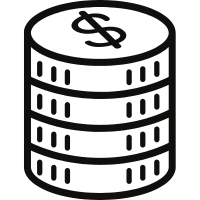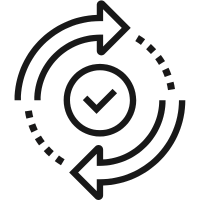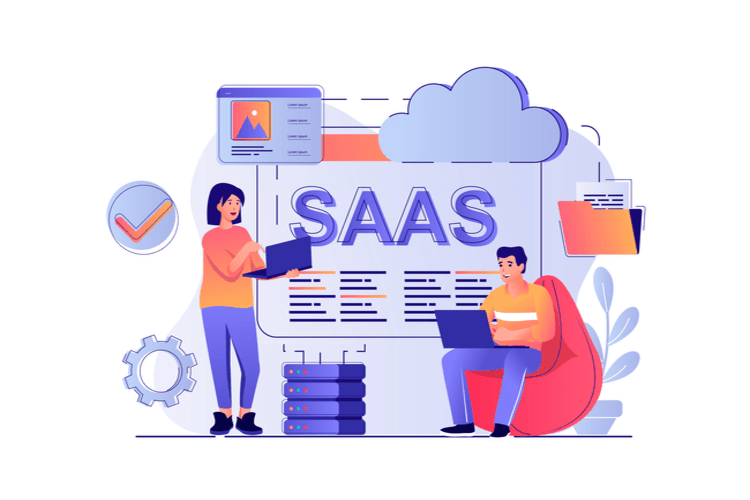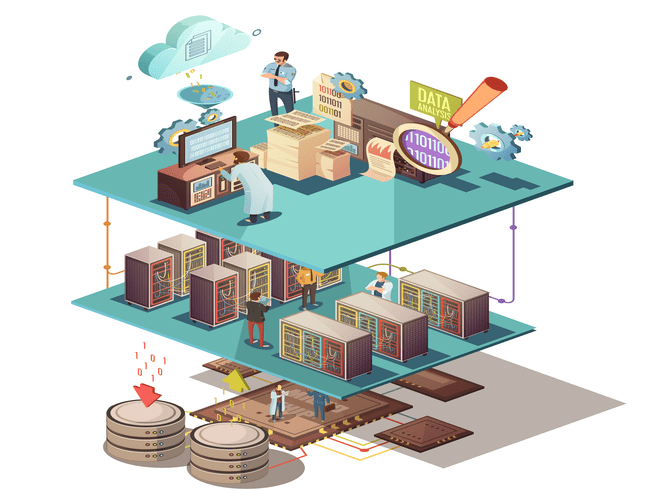SaaS application development has become a necessity rather than an optional upgrade these days. The reason you ask? In this ever-evolving market, a new disruptive technology takes the spotlight before businesses are well accustomed to the technology that came before it. So it doesn’t make sense for a business to commit to a single technology only to see it become the next best thing just a few months later.
Do you remember the good (well, arguably) old days when every application had a dedicated CD/floppy disk for it? Yeah, that was a time before SaaS application development was a thing. With cloud computing and more of such cutting-edge technologies, the majority of applications on your device are based on SaaS.
Studies show the SaaS market is expected to reach a whopping $344 Billion by the year 2027, with a steady 7.89% CAGR. Now a probable question that might come to your mind is – “How can I alleviate the major pain points of my business with the help of a SaaS application?”. Well, there’s both a quick way & an elaborate way to answer that question. The quick way would be to get in touch with us right away and let us help you with your problems. And, the elaborate way would be to go through the nitty gritties of developing a SaaS application and once you have a general idea of what SaaS development has to offer, you contact us with a clearer vision of your project. We are happy to hear from you either way!
Types of SaaS Applications
The versatility of SaaS applications and their ability to ease up a business bottleneck is the primary reason for their popularity among businesses of every scale, let’s discuss these abilities and use cases in detail:

[1] Collaboration and Communication Services
You can build a SaaS app to improve collaborative communication amidst your employees with services like text messaging, video conferences, data sharing, progress synchronization platforms, and much more. If you want a SaaS application that is custom-built for your company’s specific needs and can provide you additional advantages such as:
- Custom Collaborative Features: enhance the productivity of your business to the next level with a custom SaaS application that includes custom features based on your business niche.
- Protect Your Vital Conversations: keep your sensitive business conversations away from a third party and avoid the risk of an online breach on your business infrastructure.
- Speed Up Decision Making: make customized channels for each department and manage them easily to make agile business decisions.
Then, developing your SaaS application with a company that specializes in these services like BinaryFolks should be your go-to choice!

[2] Business Management Solutions
A business management solution helps your organization to operate in a flexible and cost-effective manner by streamlining your day-to-day activities with the help of a wide range of features. Depending on the industry and primary objectives of your organization, a SaaS-based business management solution can assist you with the core aspects of your business workflow. Some of these primary services that complement a SaaS development project are:
- Enhanced CRM Models: significantly improve the client-company relationship, generate leads & manage them for immediate or future reference.
- Cloud-based HR Solutions: remotely monitor employee performance across multiple business centers to maintain a consistent workflow.
- Finance Management Systems: manage your organization’s financial operations and plan future expenses with a SaaS-based accounting solution to maximize profit margins.
- Inventory Management Systems: keep track of individual product sales and make changes in stocking and advertising to minimize stagnant or out-of-stock inventory cases.

[3] Marketing Tools
A SaaS-based marketing automation tool helps you grow the reach of your business exponentially. Opting for the custom SaaS application development route is the better choice in this scenario, as it can help you add a personal touch on top of the generic marketing tools and enhance their performance with the help of custom features that align with your business’s marketing strategy. You can also build a marketing tool completely from scratch if necessary. Here are some of the popular features we include in our marketing enhancement tools:
- A/B Testing Protocols: try multiple versions of your marketing ideas at once to chalk down the most efficient customer acquisition strategy.
- Marketing Automation Tools: automate time-consuming tasks like email marketing, lead nurturing, and social media engagement.
- Analytics of Business KPIs: track the marketing KPIs and identify industry trends to make data-driven decisions with the help of custom marketing tools.

[4] Stat Analysis Software
Your business generates a substantial amount of data every day but in a traditional business setup, this data is only used as a reference point in case of workflow disruptions. But you can make the most of its potential by building a bespoke statistical analysis software partnering with a SaaS product development company that has been there, done that, successfully. This way you can gain valuable insights regularly from the data that is generated with your day-to-day business operations.
Here are some primary use cases where a SaaS-based statistical analysis software outshines traditional data handling strategies:
- Insightful Data Visualizations: make the business insights more engaging and easier to put into action for the stakeholders and other decision-makers.
- Data-Backed Predictive Analysis: use the previous business data to identify business bottlenecks and adjust your workflow according to the upcoming business opportunities and disruptions.
- Ease Up Big Data Analysis: evaluate large datasets that align with your business objectives to design operational strategies, understand customer behavior trends, and much more.

[5] Industry-Specific SaaS Models
In the case of different industries, the use cases of SaaS models are different depending on which of the two major categories are being used. In the case of a generic SaaS solution, a single model can pretty much cover all the industries out there. However, when it comes to a custom SaaS model, each industry has its own requirements that need to be addressed separately. Here are a few industry examples that are best complemented by custom SaaS application development services:
- Finance: to track invoices and user transactions, and notify customers regarding insurance renewals investment deadlines, and other finance-related tasks.
- Manufacturing: to manage production and maintenance deadlines, supervise the business infrastructure, and suggest optimizations based on repeated disruptive events(if any).
- Retail: to integrate modern technologies such as machine learning and predictive analysis to enhance customer satisfaction rates by analyzing shopping behavior to provide offers accordingly.
SaaS Application Architecture
The potential of your SaaS functioning is highly dependent on the SaaS application architecture you choose for your business at the seed stage of development. Opting for a SaaS architecture that fits your business operation and customer base helps your business to improve its scalability and performance for a long period. Here’s a brief overview of the most popular SaaS architectures to help you decide which one is the right choice for your business:
- Single Tenant Architecture: It is used to provide each of your customers with an individual instance of the software with their data being stored in their personal database.
- Multi-Tenant Architecture: You can use this architecture when you want multiple users to share the same piece of software for their operations.
- Hybrid Architecture: Hybrid architectures use a combination of on-premise applications and cloud-based applications to have a more flexible business approach.
- Microservices Architecture: In case your business has complex software in action, you can opt for microservices-based architecture as it divides a single software into simple loosely coupled services that can be individually developed.
- Serverless Architecture: If you’re on a limited budget then a serverless architecture can be the way to go as you only have to pay for the features that are being used instead of paying the preset amount for the entire server.
Start Your SaaS Development Journey Today
Benefits of Using a SaaS Application
Okay! Now, let’s move on from theories to implementation! It’s time to discuss what makes SaaS applications the bread and butter for optimizing businesses at every scale:
.png)
[A] Solutions that Scale with Your Business
Imagine creating a service that can adjust its offering according to your business needs. Pretty cool right? Luckily, you can build a SaaS app that can be easily tuned to scale or shrink in accordance with your business’s evolving needs for the service. Understanding your business requirements appropriately is very crucial while trying to scale your business, you can either choose to scale your business horizontally(AKA scaling out) or vertically(AKA scaling up) depending on the requirements necessary for your business growth:
- Choosing to scale your business horizontally can help you manage the increased footfall on your SaaS platform effectively by adding more servers to distribute the traffic evenly. This helps you to avoid disruptions like server crashes and high loading times due to the increased load on your servers.
- Alternatively, your company may opt to scale your business vertically in case your user base requires additional features on top of the pre-existing features quite often. In this scenario, SaaS solutions can stack features on top of the pre-existing server to match the needs of the users without adding any additional servers.

[B] Flexible Solution Models for Your Client Base
Imagine you’re providing a SaaS-based service to your customer base and they have to pay for every single feature included in the subscription even if they’re not using all of them. Doesn’t make sense, right?
Now, consider an alternate situation where your customers can add in the required features only and pay for solely that chosen feature set & no junk!
Our custom SaaS development ensures that the applications we design are user-oriented, which means they enable your customers to flexibly select the features that serve their purpose the best. This helps them optimize their business workflow and to chip down on overhead costs, which ultimately boosts the clients’ loyalty toward your services.

[C] Cost Effective
Speaking of reducing overhead costs for your client base, providing services on a subscription-based model gives your clients the power to regulate business operations according to their comfort. The fact that the customers can bail in and out of your services anytime they want without making a huge commitment makes them less hesitant towards trying out your services. And once you have the customers using your services, you can impress them with the facilities your services provide. This is an effective way of providing cost-effective services that can ultimately help you gain loyal clients.
But that’s not it, a SaaS product development project can help your business to reduce its in-house expenses as well. With almost all of the SaaS products using cloud computing services these days, installing a SaaS solution can significantly drop the infrastructural and licensing costs of your business. Compared to the traditional software installations that used to cost you an arm and a leg, this is an optimal alternative.

[D] Easy Deployment
The fact that there is no compulsion of installing sophisticated infrastructure in your business environment, during SaaS software development. This helps your organization save some extra bucks and enhance your profit margins, providing you with some extra wiggle room in the R&D budget of your business.
But that’s not it, the use of cloud computing services over traditional infrastructure makes the process of deploying SaaS-based solutions super efficient as SaaS applications can be operated right from your browsers and can give you access to the complete set of services from a single UI. In contrast to the traditional software model that requires individual computers for every service they offer.
Using traditional software also makes the deployment of new features much more time-consuming and expensive compared to SaaS applications. As you may have to install completely new local machines for the features in case it uses a different technology. However, in a SaaS application, the users do not have to worry about the infrastructure, they can add a new feature with just a few clicks while the service providers manage the infrastructure!

[E] Accessible
We mentioned that a SaaS platform can be accessed right from your browsers or custom-made applications, this makes your business remotely accessible to the stakeholders as well as the customers. In case of any special compatibility requirements, you need to mention the high-level requirements to your SaaS application development company during the initial phase of the development itself. Requirements such as mobile application development, low-end accessibility, and multilingual interfaces can be easily addressed by the developers to make sure the SaaS can serve a larger domain of customers.
All of these accessibility features are hard to implement in a traditional software solution as it is built to be accessed locally and thus once out of the room, you cannot access the services. This particularly has a negative impact in case of any off-hour operations. This is why traditional software is becoming more and more obsolete as almost all industries are shifting towards providing customers with a 24/7 service model.

[F] Frequent Updates and Maintenance
In the case of a traditional software update, the user has to download the new software and install it manually, this requires a minuscule amount of technical understanding. But it is not necessary that every user of the given software would have the necessary technical knowledge to perform this task. This may limit the number of users who can take advantage of the updates from time to time. In the case of the SaaS development process, the service providers can handle these updates by themselves. The users can have access to the latest version of the application automatically when they log in without any additional steps.
When it comes to the maintenance of these applications it is pretty identical to how the updates are handled. In the case of SaaS applications, the service provider handles all of the maintenance-related operations by themselves. For traditional software, the maintenance is pretty much handled by the service provider as well, however, the maintenance cycles are not as frequent compared to a SaaS platform.
Discuss your SaaS Project with BinaryFolks
Difference Between Web and SaaS Applications
Although SaaS applications and web applications may look similar initially, due to the following reasons:
- Both are accessible through a browser
- Both have identical user interfaces
- Both use a similar tech stack for their operations
There are a few fundamental differences between the two that you should keep in mind during the SaaS app development. Let’s discuss them one by one:
1. Taking Responsibility – Climb a Mountain or Lounge on a Hammock, The Choice is Yours
In the case of a web application, the solution is locally installed in the user’s infrastructure as they are also the owner of the technology. And all the operations such as maintenance, updates, and research for the development of the application should also be handled by the users. Whereas for the SaaS applications, all the operations are handled by the service providers themselves. The users usually do not own the SaaS application either, they are licensed to access it based on a subscription-based model. The users use the internet to access the service provider’s servers, which are based on cloud computing services.
2. Customizability – A Tailored Suit Vs a Uniform
As we discussed previously, a SaaS-based application is completely handled by the service providers in contrast to a web application that is managed by the user themselves. This makes SaaS applications much more flexible in terms of the services they provide. A user can easily add and remove the features according to their requirement within seconds, but this is not the case for a web application. During the web application development, you provide the developers with a list of features based on the trending market trends of the time that you wish to add to your app.
Once the web application developer has finalized and deployed your solution, adding additional features can be a hassle in case of a new market trend. Adding a new feature may require changes in the code base and the general architecture of the application. This will require you to hire a team of web developers every time you wish to add a new feature, which may put a giant hole in your pocket.
Developing a SaaS Application (Step-By-Step Guide)
From a small-scale startup to a full-blown mega business, everyone is looking for a SaaS application development company to streamline their business’ pain points with a solution model. Our developers have a flawless track record of developing solution models that reflect our client's vision in their solution models just the way they wanted to. Wondering how we make this happen? Here’s a step-by-step guide:

[1] Charting the Course for the Project Up Ahead
The first step towards developing your SaaS project is to provide us with a macroscopic roadmap of your requirements and expectations from the project. We would recommend our recommendations on top of your idea based on our industry expertise or based on a market analysis that we perform if deemed necessary. Additionally, we would provide you with a general guideline regarding the technologies and algorithms we will be using for the development of your project. You can also mention any additional requirements you have regarding the overall design of the application in this step.

[2] Collecting the Data Blocks for the Solution Model
After we obtain a general understanding of your requirements, we start analyzing your business data to verify whether your data will be sufficient for the development of the SaaS platform. In case the data is not sufficient for the SaaS application development we discuss this situation with you and your stakeholders with appropriate reasons for why we think the data is not sufficient. This is also the point where we take a step back and assess the entire project to give you a thoroughly analyzed quote for the entire development process. Once we shake on everything, the development phase starts!

[3] Laying the Groundwork of the SaaS Project
After the discussion phase is over our technical team starts working on the front and back ends of the project. Our developers account for every single user interaction scenario to develop a refined UI/UX model for your application. We keep the design engaging yet simple to make sure that anyone can easily work their way around the interface without being confused.
Simultaneously our project manager and quality assurance experts continuously test the model on every required platform to find any bugs that affect the reliability of the application and get them fixed immediately.

[4] Testing and Refining the Developed Product
Once the development phase is over we provide you with an MVP(Minimal Viable Product) that has the core functionalities of the final product along with a few simple features. This product can either be launched for the internal use of the business or can be assigned to a specific team of users to gain feedback from during the upcoming processes.
After the MVP starts to engage a user base, our developers continue to thoroughly assess and refine the model based on the user feedback and the additional requirements of the product.

[5] Deployment – Time to Cut the Ribbon
Once the testing and refinement phase of the SaaS application is over, it is time to deploy the SaaS application to its final environment. This is where it can be accessed by the SaaS application's intended user base. Initially, the application is accessible to a very limited number of users. This is the alpha phase, where the main goal for our developers is to observe how the application's core aspects perform in the final environment. The developers look for any isolated bugs in the application or any other bugs that may arise when the application interacts with the remaining business infrastructure.
After the alpha phase is complete the application is pushed to the beta phase, here our developers focus on analyzing the more complex aspects of the app such as the scalability, performance, and functionality. Being the penultimate stage of the application deployment the beta phase caters to a large audience to get more refined insights for the software.
Once all the user feedback is addressed and the stakeholders have approved the model from their ends the product is finally launched at its full potential to be used by the entire user base.

[6] Maintaining the Model for the Long Run
Once the final application is deployed you need to schedule maintenance of the model from time to time to make sure that the application is operating the way it was intended. You should always be on your toes to hastily fix any issues or bugs that may arise post-deployment. You can ask us for help if it is a serious concern or have your in-house technical team get it done if it falls under their expertise. Finally, you should always keep your eyes open for any new opportunities in your domain and be the first to take action before anyone else. We are always happy to help you out with a new development venture.
What Makes BinaryFolks the Premier Pick to Develop Your SaaS Solution?
Now that you have acquainted yourself with all the technicalities of developing a SaaS application, it’s time to leverage your very own SaaS application to help you refine your business operations. Here’s how BinaryFolks can help you achieve this goal with their extensive experience and expertise in the domain:

(1) Develop Scalable and Accurate SaaS Applications with BinaryFolks
Use BinaryFolks’ SaaS product development to design scalable applications that can help businesses to operate their business remotely without the need for a heavy-duty infrastructure. At BinaryFolks, we have hands-on experience with developing feature-packed services with clean and professional interfaces. Train your employees, even the ones with zero technical familiarity to use these services effectively in a short time and take your legacy business online.

(2) Enhance the Long Term Productivity and Profit Margins of your Business with BinaryFolks
You may hesitate to implement a new technology thinking about the short-term cash flow of your business and shrunken profit margins for that year. But if you’re more concerned about the big picture then elevating your business with a SaaS application will be one of the best decisions you can take for your business at this point.

(3) Work with Developers and Consultants who Mastered the Craft of Developing SaaS Applications.
We have a team of innovative developers & consultants with hands-on experience in multiple SaaS projects across various industries. Each member of our team provides a unique skill to the project, collectively we are able to consistently deliver products that are not only reliable but also worth every penny of your investment.
Our SaaS developers design a solution with the user base in mind and try to use the architecture that best fits your business goals. Our project management and quality assurance teams and always on alert mode to make sure that the code is working flawlessly. In addition, they continuously test the product to find any performance issues and get them fixed promptly.
Conclusion
Well, now you have covered all the information you need to start your SaaS application development venture! We covered the benefits of using a SaaS platform, along with its primary use cases. We also took a quick look at our development process, to help you understand the way we tackle our clients’ business pain points. Furthermore, we checked out various trending architectures that SaaS applications use these days, to give you an idea of which one would be more suitable for your business needs!
What? You’re 99% convinced but can’t seem to make a choice because your use case is pretty unique and no one is talking about it? Don’t worry! We got you! You can contact us to set up a meeting and quickly discuss your requirements with our SaaS consultants to get that remaining 1% confidence. Alternatively, you can provide us with the high level requirements for your custom SaaS application and shoot it our way, and we will get back to you with a solution that meets your needs!
Get Complimentary SaaS Consultancy




Resized%20650%20X%20500.png)
.png)
.png)